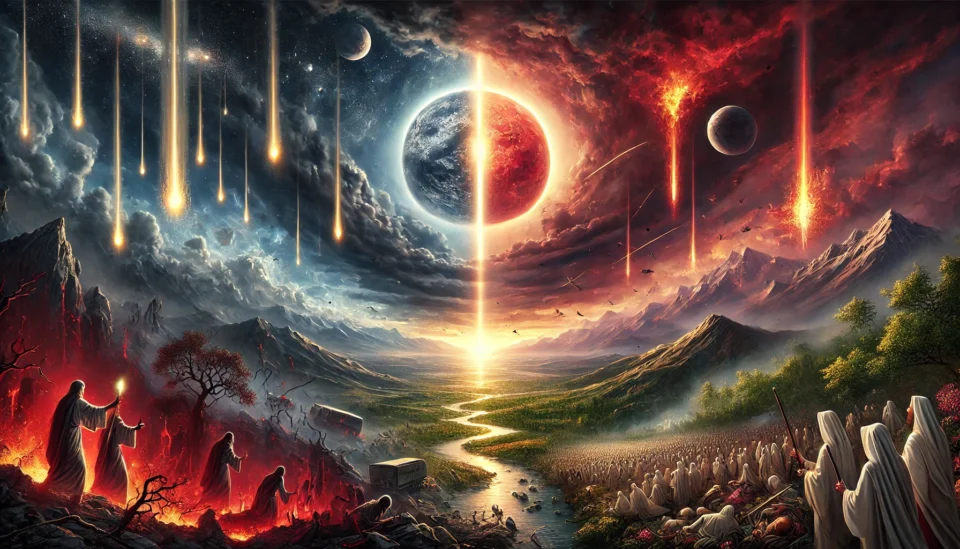The “Day of the Lord” is a biblical concept that appears throughout both the Old and New Testaments. It generally refers to a time of divine intervention when God acts decisively in human history. This phrase carries both a sense of judgment and hope, depending on the context.
- The Day of the Lord often symbolizes judgment upon nations or peoples for their sins.
-
- Amos 5:18-20 warns Israel not to desire the Day of the Lord, as it will be a time of darkness and judgment for them. Woe to you who long for the day of the Lord! Why do you long for the day of the Lord? That day will be darkness, not light. 19 It will be as though a man fled from a lion only to meet a bear, as though he entered his house and rested his hand on the wall only to have a snake bite him.
20 Will not the day of the Lord be darkness, not light— pitch-dark, without a ray of brightness? - Isaiah 13:6-13 describes the Day of the Lord as a time of cosmic upheaval, when God judges Babylon and other enemies of His people.
- Amos 5:18-20 warns Israel not to desire the Day of the Lord, as it will be a time of darkness and judgment for them. Woe to you who long for the day of the Lord! Why do you long for the day of the Lord? That day will be darkness, not light. 19 It will be as though a man fled from a lion only to meet a bear, as though he entered his house and rested his hand on the wall only to have a snake bite him.
-
Read also Why Meditation is Essential for Spiritual Growth
- 2. The Day of the Lord is expanded to refer to the second coming of Christ, a time when God will bring ultimate justice, establish His kingdom, and fulfill His promises.
- 2 Peter 3:10 describes it as a day when the heavens will pass away, the elements will be dissolved, and the earth will be laid bare. But the day of the Lord will come like a thief. The heavens will disappear with a roar; the elements will be destroyed by fire, and the earth and everything done in it will be laid bare.[a]
- 1 Thessalonians 5:2 mentions that it will come like “a thief in the night,” emphasizing its sudden and unexpected nature. for you know very well that the day of the Lord will come like a thief in the night.
Read also 9 Ways to know Gods will
3. The prophets often used the “Day of the Lord” to warn Israel and other nations of impending judgment due to sin. It was seen as a day when God would intervene in history to punish evil and vindicate His holiness.
-
- Joel 2:1-11: Describes an army bringing destruction as part of God’s judgment. It is both literal and symbolic, emphasizing repentance (
- Obadiah 1:15: States, “The day of the Lord is near for all nations. As you have done, it will be done to you; your deeds will return upon your own head. highlighting its global scope.
4. The Day of the Lord is often accompanied by vivid descriptions of natural disasters, darkness, and trembling of the earth:
-
-
- Isaiah 2:12-21: Depicts human pride being humbled as God alone is exalted.
- Zephaniah 1:14-18: Speaks of a “day of wrath” with distress and ruin.
- Judgment for the Wicked: God will punish those who oppose His will and oppress others.
- Deliverance for the Faithful: For those who trust in God, it is a day of vindication and restoration.
-
Read also Amos 3:3
5. Day of the Lord as the culmination of history when Christ returns.
-
- Jesus describes His return with cosmic signs and the gathering of the elect.29 “Immediately after the distress of those days “‘the sun will be darkened, and the moon will not give its light; the stars will fall from the sky, and the heavenly bodies will be shaken.’[a] 30 “Then will appear the sign of the Son of Man in heaven. And then all the peoples of the earth[b] will mourn when they see the Son of Man coming on the clouds of heaven, with power and great glory.[c] 31 And he will send his angels with a loud trumpet call, and they will gather his elect from the four winds, from one end of the heavens to the other. –Matthew 24:29-31:
- Revelation 6:12-17: The sixth seal unleashes terror as people recognize the arrival of God’s wrath.
-
Read also How to become a servant leader
6. The Day of the Lord isn’t just about destruction—it’s also a time of renewal.
- The faithful look forward to a “new heavens and a new earth” where righteousness dwells (2 Peter 3:13; Revelation 21:1-4).
- 1 Thessalonians 5:1-11: Paul reminds believers to remain alert and live as “children of the light,” prepared for Christ’s return.
- 2 Peter 3:8-13: Encourages patience, explaining that God’s timing reflects His desire for repentance.
- Hope and RenewalRead also 10 Points on How to Cultivate a Daily Prayer Routine
7. The “Day of the Lord” often has near (immediate) and far (eschatological) fulfillments.
Near Fulfillment
-
- In Joel’s time, the locust plague was seen as a harbinger of the Day of the Lord, calling Israel to repentance (Joel 1:15, 2:1).
- Similarly, historical events like the fall of Jerusalem in 586 BC (Lamentations) foreshadowed greater judgments to come
.Far Fulfillment
-
-
- The ultimate Day of the Lord includes Christ’s second coming, the final judgment, and the establishment of a new creation (Revelation 20-21).:
- The ultimate Day of the Lord includes Christ’s second coming, the final judgment, and the establishment of a new creation (Revelation 20-21).:
-
